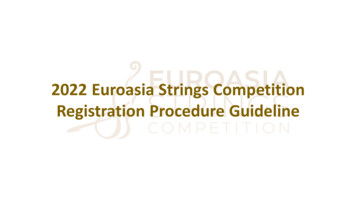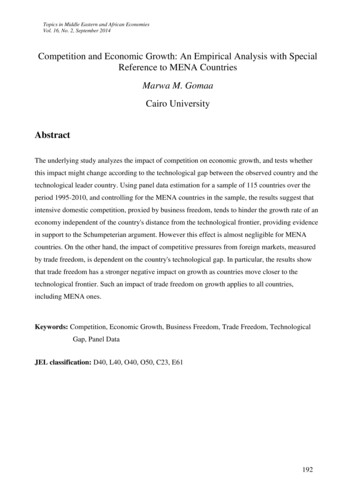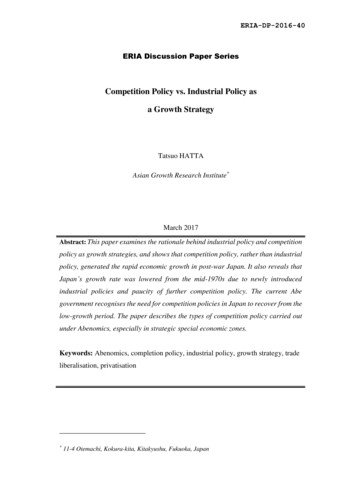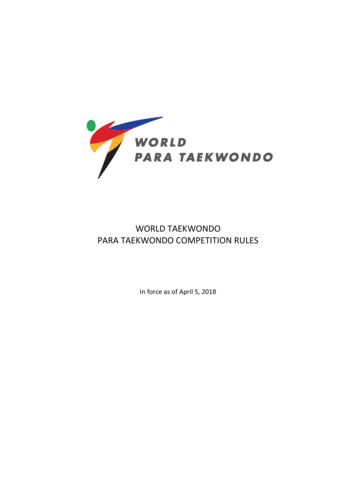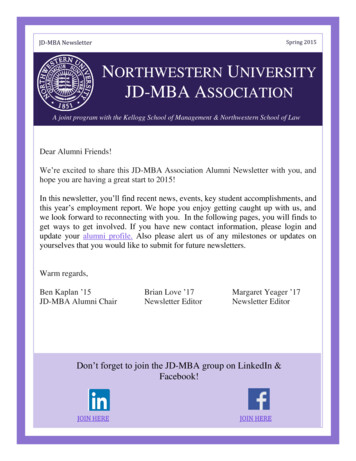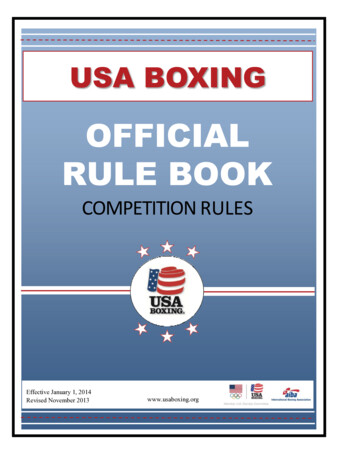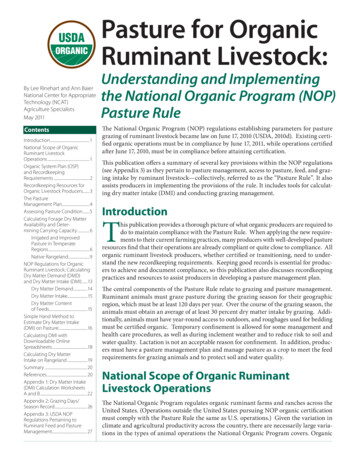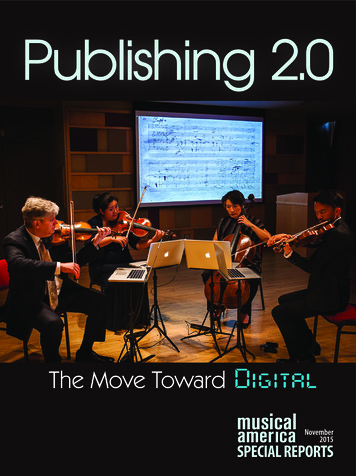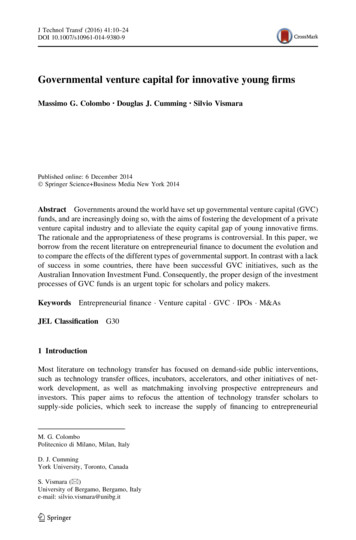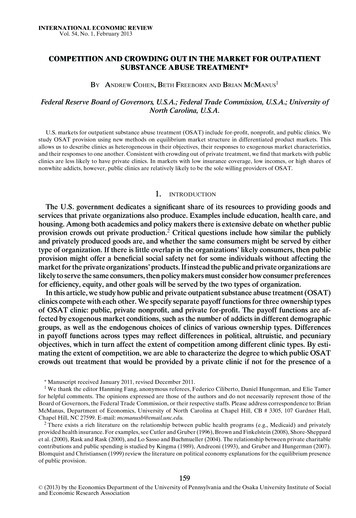
Transcription
INTERNATIONAL ECONOMIC REVIEWVol. 54, No. 1, February 2013COMPETITION AND CROWDING OUT IN THE MARKET FOR OUTPATIENTSUBSTANCE ABUSE TREATMENT**BY ANDREW COHEN, BETH FREEBORN AND BRIAN MCMANUS1Federal Reserve Board of Governors, U.S.A.; Federal Trade Commission, U.S.A.; University ofNorth Carolina, U.S.A.U.S. markets for outpatient substance abuse treatment (OSAT) include for-profit, nonprofit, and public clinics. Westudy OSAT provision using new methods on equilibrium market structure in differentiated product markets. Thisallows us to describe clinics as heterogeneous in their objectives, their responses to exogenous market characteristics,and their responses to one another. Consistent with crowding out of private treatment, we find that markets with publicclinics are less likely to have private clinics. In markets with low insurance coverage, low incomes, or high shares ofnonwhite addicts, however, public clinics are relatively likely to be the sole willing providers of OSAT.1.INTRODUCTIONThe U.S. government dedicates a significant share of its resources to providing goods andservices that private organizations also produce. Examples include education, health care, andhousing. Among both academics and policy makers there is extensive debate on whether publicprovision crowds out private production.2 Critical questions include how similar the publiclyand privately produced goods are, and whether the same consumers might be served by eithertype of organization. If there is little overlap in the organizations’ likely consumers, then publicprovision might offer a beneficial social safety net for some individuals without affecting themarket for the private organizations’ products. If instead the public and private organizations arelikely to serve the same consumers, then policy makers must consider how consumer preferencesfor efficiency, equity, and other goals will be served by the two types of organization.In this article, we study how public and private outpatient substance abuse treatment (OSAT)clinics compete with each other. We specify separate payoff functions for three ownership typesof OSAT clinic: public, private nonprofit, and private for-profit. The payoff functions are affected by exogenous market conditions, such as the number of addicts in different demographicgroups, as well as the endogenous choices of clinics of various ownership types. Differencesin payoff functions across types may reflect differences in political, altruistic, and pecuniaryobjectives, which in turn affect the extent of competition among different clinic types. By estimating the extent of competition, we are able to characterize the degree to which public OSATcrowds out treatment that would be provided by a private clinic if not for the presence of a Manuscript received January 2011, revised December 2011.We thank the editor Hanming Fang, anonymous referees, Federico Ciliberto, Daniel Hungerman, and Elie Tamerfor helpful comments. The opinions expressed are those of the authors and do not necessarily represent those of theBoard of Governors, the Federal Trade Commission, or their respective staffs. Please address correspondence to: BrianMcManus, Department of Economics, University of North Carolina at Chapel Hill, CB # 3305, 107 Gardner Hall,Chapel Hill, NC 27599. E-mail: mcmanusb@email.unc.edu.2 There exists a rich literature on the relationship between public health programs (e.g., Medicaid) and privatelyprovided health insurance. For examples, see Cutler and Gruber (1996), Brown and Finkelstein (2008), Shore-Sheppardet al. (2000), Rask and Rask (2000), and Lo Sasso and Buchmueller (2004). The relationship between private charitablecontributions and public spending is studied by Kingma (1989), Andreoni (1993), and Gruber and Hungerman (2007).Blomquist and Christiansen (1999) review the literature on political economy explanations for the equilibrium presenceof public provision.1159 C(2013) by the Economics Department of the University of Pennsylvania and the Osaka University Institute of Socialand Economic Research Association
160COHEN, FREEBORN, AND MCMANUSgovernment-run treatment center. Conversely, we are able to identify the markets in which theobserved public OSAT clinic is the only feasible type of addiction treatment, because privateclinics are unlikely to serve the market.Our approach to competition and crowding out among OSAT clinics follows from a model ofequilibrium market structure. We assume that potential public, nonprofit, and for-profit clinicsstrategically consider whether to serve a market, and each observed choice to serve (or not)reflects an optimal decision conditional on the clinic’s objective, local market conditions, andthe choices of other (potential) clinics. Observed market structures therefore correspond topure-strategy equilibria in complete-information simultaneous-move discrete games, althoughthere are other games that also share the equilibrium conditions. The discrete nature of theclinics’ interaction can lead to multiple market structures satisfying the equilibrium conditionsfor a single market, as is often the case in entry games. For example, a local government maychoose not to open a public clinic if the local populace places no pressure on their electedofficials because the residents believe that existing private clinics provide adequate service.Alternatively, if the same market instead has an active public clinic, a potential private clinicmay choose not to operate because the residual demand for its treatment services is insufficientto cover operating expenses. Our model allows us to calculate the likelihood that an observedmarket structure is the only possible configuration for a market satisfying the participationconditions, and therefore identify cases in which public OSAT prevents the operation of aprivate clinic.To estimate our model, we build on recently developed empirical techniques for estimatingdiscrete games with heterogeneous strategic agents. In particular, we closely follow Cilibertoand Tamer’s (2009) procedure for estimating the parameters of a game in which more than oneoutcome may be consistent with the underlying economic model, but no equilibrium selectionmechanism is imposed to resolve the multiplicity. Our results indicate that payoff functionsdiffer across OSAT providers, and each clinic ownership type is sensitive to the presence of thetwo remaining clinic types. A central implication of this result is that potential private clinicssometimes forgo offering OSAT in a market because a public clinic is present, i.e., privatetreatment is crowded out.Multiple equilibria in the identities of OSAT providers appear often in our sample of 1,583rural U.S. markets. Averaging across markets, the identified parameter set, and the distributionof unobservables supporting the empirical outcome as an equilibrium, we find a likelihoodof about a third that there is another equilibrium that was not realized. The possibility ofmultiple equilibria is of particular interest when a market’s OSAT is provided by a single publicclinic. In these cases, there is a sharp distinction between crowding out of private clinics and,alternatively, the chance that public and private clinics serve different types of markets, in whichcase the removal of the sole public clinic would lead to an absence of OSAT. Among the 224markets with a single public clinic in our data, the chance of multiple equilibria is relativelyhigh—about two-thirds—implying that public OSAT often exists to the exclusion of privatetreatment. The full extent of crowding out in these markets is actually greater (between 70%and 78%) due to cases in which a unique equilibrium of public OSAT is replaced by privateOSAT if government treatment is made impossible. Due to the heterogeneous characteristicsof nonprofit and for-profit private clinics, we find that when crowding out exists, it is morelikely to be between public and nonprofit clinics. Despite our finding of substantial crowdingout of private OSAT in general, we uncover interesting variation in this impact across markets.Markets with lower median income, a greater share of addicts who are nonwhite, and a greaterportion of its population without health insurance are more likely to lose OSAT entirely if apublic clinic is removed from the market.With this article, we contribute to the recently initiated literature on estimating discretegames in which multiple outcomes may be consistent with the underlying economic model.We follow the method of Ciliberto and Tamer (2009), who assume that observed marketstructures satisfy a minimal set of conditions on firms’ payoffs, where the conditions hold ina variety of settings including any pure-strategy Nash equilibrium of a simultaneous-move
COMPETITION AND CROWD OUT IN REHAB161complete information game among firms making choices about participation in a market. Amarket’s exogenous characteristics and the players’ discrete choices are sufficient to estimatethe parameters of reduced-form payoff functions for the games’ players. The method buildson earlier work on discrete games (Bresnahan and Reiss, 1991a; Berry, 1992; Mazzeo, 2002),which have used assumptions on player homogeneity, equilibrium selection mechanisms, or thetiming of choices to avoid the possibility of multiple equilibria. Such restrictions may not beappropriate for OSAT markets, which are complicated by likely differences in agents’ objectivefunctions and the policy relevance of whether public clinics crowd out private clinics.We also contribute to the literature on competition in medical markets, which includes several recent studies of the significant differences that exist across hospitals of different ownershiptypes. Chakravarty et al. (2006) compare the entry and exit choices of for-profit and nonprofithospitals and find that the former are more sensitive to exogenous changes in demand. Duggan (2000, 2002) offers empirical evidence that public, nonprofit, and for-profit firms responddifferently to an exogenous change in financial incentives. Norton and Staiger (1994) showthat for-profit hospitals are just as likely to offer charity care as nonprofit hospitals when theyoperate in similar markets, but for-profit hospitals are more likely to select markets with lessdemand for charity care. Horwitz and Nichols (2009) find that services offered by hospitals varysystematically with the type of hospital and the share of for-profit hospitals within the market.3In this article, we extend this literature by directly accounting for the endogenous relationshipsamong health care providers of different ownership types and do so with minimal restrictionson the equilibrium that may be selected in the observed markets.The remainder of the article is organized as follows. Section 2 presents background onthe provision of OSAT services. In Section 3, we describe the economic model that we assumegoverns the operating decisions of potential OSAT providers. We describe the data in Section 4,and Section 5 contains our approach to estimating the parameters of the economic model.Section 6 presents the empirical results, which include our crowding-out measures. Section 7concludes. We collect additional details on the data and estimation approach in the Appendix.2.OSAT INSTITUTIONAL BACKGROUNDAn estimated 16.6 million Americans (7.3% of adults) were classified as having a substanceabuse disorder in 2001, and 3.1 million received some kind of treatment.4 Substance abusetreatment is a large market, with 18 billion spent on treating substance abuse disorders in theU.S. during 2001. The demand for treatment options is increasing as public support for treatment(instead of punishment) broadens and the number of substance abusers continues to grow.5 Overhalf of all funding for substance abuse treatment is public. State and local governments provide38% of all substance abuse treatment funding, whereas Medicaid accounts for another 19%.Treatment services are provided by a variety of types of organizations. In addition to publicproviders, which represented 15% of U.S. treatment facilities in 2000, nonprofit and for-profitorganizations accounted for approximately 59% and 26% of all treatment facilities, respectively.Although the common interpretation of substance abuse “rehab” often is of treatment inan inpatient (residential) setting, far more treatment programs provide outpatient services. In2000, 82% of all substance abuse treatment facilities offered outpatient services, and aboutthree-quarters of all nonemergency patient treatment admissions were for outpatient services.63 For other examples that contrast the objectives and characteristics of nonprofit and for-profit hospitals, see Gaynorand Vogt (2003), Eid (2006), and Abraham et al. (2007).4 See Substance Abuse and Mental Health Services Administration (SAMHSA, 2002). These levels have continuedin more recent years. In 2008, SAMHSA estimated 22.2 million (8.9% of the population) had a substance abuse disorderand an estimated 4.0 million received treatment.5 Mark et al. (2005) estimate that spending on substance abuse treatment increased an average of 4.6% per yearbetween 1996 and 2001. They also provide an extensive discussion of expenditures on substance abuse treatment.6 Emergency treatment occurs when a patient requires immediate detox and is suffering from acute medical complications.
162COHEN, FREEBORN, AND MCMANUSClinics of all ownership types provide outpatient treatment, although in our sample the distribution of types across markets departs slightly from the statistics described above, which pertainto treatment of all forms in large and small U.S. markets.There is some evidence that ownership structure is correlated with clinics’ choices. Forexample, Wheeler and Nahra (2000) find that for-profit clinics treat a larger proportion ofheroin addicts and fewer alcohol abusers than nonprofit and government clinics. Additionally,clinics vary in the forms of payment they accept, with for-profits accepting Medicare, Medicaid,and various forms of insurance less frequently than public and nonprofit clinics.7 All types ofclinics—including 80% of public clinics—accept cash payment for treatment.In executing our analysis, we assume that government clinics are uniform in their objectivesand responsiveness to competition from private clinics. This includes clinics that are operated bya state government (27% of public clinics); a local, county, or community government (56%);or the federal government (17%). Although there may be differences in decision making atdifferent levels of government, in this article we are more concerned with choices of privateorganizations as they relate to the presence of public OSAT clinics. In addition, our model mayaccommodate some differences across public clinics through the model’s neutrality regardingequilibrium selection.3.ECONOMIC MODELIn this section, we present a model to characterize the behavior of the three OSAT providertypes. The model assumes that the decision whether or not to operate a clinic for each potentialOSAT provider is governed by a payoff function that differs across the three types. As describedin Bresnahan and Reiss (1990, 1991a) and Mazzeo (2002), the operating decisions of potentialclinics can be used to infer a long-run reduced-form payoff function. This function representsthe return from current and future product market competition for each type of clinic, giventhe assumption that operating clinics receive positive payoffs and clinics not active in a marketwould receive negative payoffs from operating. The payoff function for each type depends ona set of economic variables specific to the particular market as well as the decisions made byother agents in the market.The payoff functions differ across types because each is likely to pursue different objectives.Although for-profit clinics are likely to maximize profits, public and nonprofit clinics may haveother goals. For example, nonprofit organizations may be more focused on serving portionsof the population with particular demographic backgrounds, and government participationmay be responsive to tax revenues or political pressure to provide OSAT for the indigent.These differences in clinics’ unobserved objective functions will be reflected—but not explicitlycaptured—in the reduced-form responses of clinics to market demographics.We assume that every market (m) is populated by potential OSAT providers of each type(t): government (G), private nonprofit (N), and private for-profit (F). The observed numberof clinics of type t in market m is ntm , and the vector of clinics in m is nm (n Gm , n Nm , n Fm ).We write n t,m to indicate the vector of clinic counts for types other than t. The payoff functionof a type-t clinic in market m is πtm . This function is a reduced-form representation of a firm’sstructural objective, and its value depends on the presence of other clinics; a set of observeddemand and cost shifters, W tm , which includes some variables that affect all clinics’ payoffsand other variables that affect only a single clinic type; a parameter vector θt ; and unobserved(to the econometrician but not to potential clinics) payoff shifters, εtm . All potential clinics inm observe all values of εtm before making their choices whether to offer OSAT in a market.87Available payment methods may be linked to treatment offerings. Olmstead and Sindelar (2005) report thatincreases in managed care penetration cause for-profit clinics to offer more services and public clinics to offer fewerservices.8 Pakes et al. (2006) allow the error to contain both a structural component (similar to our assumption on ε) plusadditional measurement or expectational error on behalf of the agent. Seim (2006) considers a Bayesian game in whichagents know the distribution of the unobservables but do not observe their realizations.
COMPETITION AND CROWD OUT IN REHAB163Active clinics’ payoffs are additive in the unobservable εtm , and each potential clinic receives apayoff of zero if it chooses not to offer OSAT in the market. That is,(1)πtm (nm , Wtm , εtm ; θt ) πtm (nm , Wtm ; θt ) εtmif the clinic operates in the market,πtm (nm , Wtm , εtm ; θt ) 0for a potential clinic that does not operate in the market.Finally, we assume that the presence of competing clinics acts to reduce the payoffs of antm 0, where n t,m represents any other individual clinic that may alsoindividual clinic: n π t,mserve market m.In our empirical application, we limit the number of potential values nt may take in order tomatch the patterns we observe in the data and to maintain tractability.9 For public and for-profitclinics, we specify that nt {0, 1}, whereas nonprofit clinics, which are more numerous, mayhave nN {0, 1, 2}. We assume that the presence of a second nonprofit clinic reduces the profits πNm 0. In the remainder of this section we occasionally invokeof the first nonprofit as well: nN,mthese limits on nt in explaining certain features of our model.3.1. Equilibrium and the Data Generating Process. We assume that an organization choosesto operate a clinic if and only if its payoffs are nonnegative, given the choices of the other clinicsin a market. That is, our economic model requires that the payoffs of each type of firm, for agiven market structure, satisfy the following two conditions: (C1) Each organization with anactive clinic must receive a nonnegative payoff, and (C2) each organization without an activeclinic would receive a negative payoff from operating in the market. We define an equilibrium,therefore, as any configuration (nG , nN , nF ) satisfying the following inequalities describing therealized and potential payoffs for each clinic type:πt (n t , n t , Wt , εt ; θt ) 0 (Condition C1)πt (n t 1, n t , Wt , εt ; θt ) 0 (Condition C2)We suppress the market (m) notation on π for convenience. When we observe a clinic count atits maximum (1 or 2, depending on t) in a market, only condition C1 is necessary to describethe equilibrium for the affected clinic type.The inequalities in C1–C2 represent an intuitive yet minimal set of conditions that we assumehold for any observed market structure. These conditions are necessary for a pure-strategyNash equilibrium in a simultaneous-move game over market participation. More generally,Ciliberto and Tamer (2009) describe cross-sectionally observed markets structures as snapshotsof the long-run equilibrium in a dynamic game of entry and exit. We do not impose restrictionsbeyond C1–C2 to guarantee a unique equilibrium market structure, nor do we limit the empiricalpredictions of the model to features that are invariant across all equilibria, such as the totalnumber of active clinics.10 Although in this article we often use the language of simultaneousmove games to describe clinic behavior, conditions C1–C2 are also necessary conditions forequilibria in some complete-information sequential-move games. For example, Mazzeo’s (2002)sequential game of motel entry and type selection satisfies C1–C2. More generally, it is possibleto specify a sequential OSAT clinic entry game in which potential clinic operators continuemaking participation decisions until no additional players are willing to enter the market, andthis game will satisfy C1–C2.11 Other sequential-move games with a prespecified number of9Such restrictions are common in empirical studies of equilibrium market structure, beginning with Bresnahan andReiss (1991a) and continuing through Ciliberto and Tamer (2009).10 Some prior research on entry games (e.g., Mazzeo, 2002) removes the possibility of multiple equilibria by specifyinga sequential-move game with a particular order of moves combined with parameter restrictions.11 One possible game would include a finite but large number of players of each type that choose the actions “enter”or “do not enter” in some prespecified order. We might further assume that players who choose the “enter” cannot
164COHEN, FREEBORN, AND MCMANUSmoves may not satisfy C2, however, as a potential clinic that has opted out of the market mayfind that it would have positive profits from entering given the choices of clinics that move laterwithin the game. This violation of C2 could create pressure for revisions of choices or additionalrounds of the game that are not natural to rule out a priori. Likewise, conditions C1–C2 may nothold when mixed strategy equilibria are permitted in simultaneous-move games or incompleteinformation exists about clinics’ payoffs, but the apparent ex post “mistakes” that are possiblefollowing ex ante optimal behavior could bring pressure to revise actions until they are in linewith C1–C2. We do not consider mixed strategies or incomplete information in this article.When the impacts of W and n t on payoffs are finite and ε has sufficiently wide support,then conditions C1–C2 admit multiple equilibria with positive probability in any market.12Conditional on knowing the true value of θ along with a market’s W, statements regardingcrowding out must be probabilistic in that they depend on restrictions on realizations of thevector of error draws, ε. Whenever a particular clinic type is not observed in a market, therealized εt may be such that a particular clinic type would either (1) operate and earn positiveprofits in some equilibria, but not the one that was played, or (2) earn negative payoffs in anyconfiguration in which the other types behave optimally. As discussed below, our model allowsus to distinguish between these two possibilities.The possibility of multiple n satisfying C1–C2 for a single ε implies that this is an “incomplete”econometric model in which we cannot use standard estimation techniques such as maximumlikelihood to estimate θ (see Tamer, 2003). The model is incomplete in that we do not specifyan equilibrium selection process to determine which n is realized in a market when multiplestructures satisfy C1–C2. Although the absence of an equilibrium selection mechanism may beviewed as a gap in the model, including a mechanism provides an additional opportunity forintroducing misspecification. Such misspecification could alter our results on crowding out andthe model’s policy interpretation. Because we have little a priori information on how multipleequilibria might be resolved in the OSAT market, we take an econometric approach that permitsinference on θ without additional assumptions on the game beyond C1–C2.3.2. Crowding Out in the Model. Crowding out can occur in two ways in our model. First,there may be multiple equilibria in a market, with the distinct equilibria varying in their numbersof clinics of each ownership type. When such equilibria exist and the realized outcome is theone in which there are more public clinics and fewer private clinics, we describe the outcomeas crowding out. Second, crowding out can occur when the unique equilibrium outcome has apublic clinic active in a market, but a private clinic is willing to operate in the market so long asthe public clinic is restricted from entry. We now provide examples of each possibility.3.2.1. Example 1: Crowding out due to multiplicity.Suppose we observe a market with(nG , nN , nF ) (1, 0, 0). Equilibrium condition C1 implies that the public clinic’s payoff must bepositive in this market. Additionally, conditional on the presence of the public clinic, conditionC2 implies that a single nonprofit or for-profit clinic would receive a negative payoff if itparticipated in the market. There may exist alternative configurations, however, that also satisfyC1–C2 for this market. For example, (0, 1, 0) may satisfy the equilibrium conditions if the publicGsufficiently negativeclinic, which was willing to participate in the market as a monopoly, has π nNto dissuade it from participation as a duopolist. Other potential alternative equilibria include(0, 0, 1) and (0, 1, 1), although these two configurations are not possible simultaneously underreverse their decision on a later turn, and the game ends when there is a sequence of consecutive turns containingplayers of each type and no player in this sequence chooses “enter.” This game will have a unique equilibrium sequenceof actions. C1 will be satisfied because no player will choose the action “enter” when it leads to negative profits. C2will be satisfied because no player would allow the game to end when it is possible to deviate to the action “enter” andreceive a positive payoff.12 Bresnahan and Reiss (1991b) show that full support on the εs guarantees the existence of multiple pure strategyNash equilibria. Also, see Cohen and Manuszak (2005) for graphical representations of the set of pure strategy Nashequilibrium outcomes for entry games with various types of strategic interactions among the players.
COMPETITION AND CROWD OUT IN REHAB165C1–C2. More generally, if we observe a market with (1, nN , nF ) where (0, n N , n F ) is an alternativeequilibrium and (n N n F ) (n N n F ), we say that crowding out has occurred due to themultiplicity of equilibria.3.2.2. Example 2: Crowding out despite a unique equilibrium.Suppose that a potentialnonprofit clinic is willing to serve a market as a monopolist, but it would receive a negativepayoff if it were to share the market with a public clinic. At the same time, a public clinic iswilling to serve the same market both as a monopolist and as a duopolist. This may occur forNG π 0, all else equal. Then (0, 1, 0) does not satisfy C2 for thesome values of ε when π nG nNG clinic, although (1, 0, 0) can satisfy C1–C2 for both G and N firms. So long as the for-profitclinic is uninterested in serving the market, (1, 0, 0) is a unique equilibrium. If a type G clinic isforbidden from serving the market, however, then the outcome (0, 1, 0) satisfies the equilibriumconditions for the other clinic types. In cases like this example, we say that crowding out hasoccurred despite the (inferred) uniqueness of the observed equilibrium with nG 1.4.DATAWe use data on the location and characteristics of OSAT facilities from the 2000 NationalSurvey of Substance Abuse Treatment Services (N-SSATS), an annual census of substanceabuse treatment facilities conducted by the Substance Abuse and Mental Health ServicesAdministration (SAMHSA). The information provided by N-SSATS includes facility ownershipstructure and the types of services offered. In 2000, there were 13,428 eligible respondentfacilities included in the survey.13 Most clinics (60%) identify substance abuse treatment as thefacility’s primary focus, and 25% report a mix of substance abuse and mental health treatmentservices. Unfortunately, the N-SSATS data does not include clinics’ prices or quantities, so weare unable to directly estimate treatment demand.We model the decision to offer OSAT in a distinct geographic area. We assume that treatment markets are defined by U.S. county borders, and we analyze choices within the 1,583counties with populations between 5,000 and 100,000 that are not within in a Metropolitan orConsolidated Statistical Area (MSA or CSA). Three considerations support this choice of market definition and size. First, as we mention above, it is computationally prohibitive to estimateour model in markets with a very large number of decision makers of each ownership type.Second, potential patients in these small, rural markets are relatively unlikely to cross countylines to receive OSAT. In our sample’s counties during 2000, 71% of the employed population worked inside their home county, whereas only 52% of working residents in similarly-sizedMSA counties worked in their home county.14 Patients who receive outpatient treatment attendseveral hours of individual and group counseling sessions per week that are scheduled aroundthe patient’s normal activities. By its very nature, OSAT patients do not travel long distances toreceive treatment. Third, the majority of public clinics are oper
half of all funding for substance abuse treatment is public. State and local governments provide 38% of all substance abuse treatment funding, whereas Medicaid accounts for another 19%. Treatment services are provided by a variety of types of organizations. In addition to public providers, which represented 15% of U.S. treatment facilities in .

